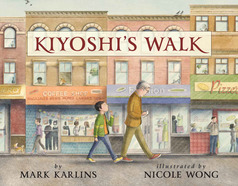Kiyoshi's Walk
 Review
Review
By School Library Journal
Kiyoshi wishes he could write haiku like Eto, his grandfather. When Kiyoshi asks him “Where do poems come from?” Eto responds by putting paper and a pen in his pocket and taking Kiyoshi for a walk. As they traverse the city all the way to the river, Eto writes poems based on what they see and hear including tumbling oranges, the flap of wings, an abandoned teddybear, and the ending of a day. Meanwhile, Kiyoshi puzzles out how to find a poem. At the river Eto asks Kiyoshi if now he understands where poems come from. Kiyoshi has been paying attention: “‘They come from here,’ he said, and opened his arms wide to take in the river and the sky and the distant buildings. ‘And they come from here,’ he said, and pointed to his own heart.” The text does an excellent job of showing the process, as it unfolds, without overexplaining or complicating the narrative. Wonderful digital illustrations complement and expand on the text, combining clean lines, realistic details, and a variety of perspectives, from bird’s-eye views to close-ups. Warm, inviting colors with pops of bright pink on the flowering trees (cherry blossoms, perhaps) provide quiet clues to location, while the people in a multicultural cityscape have a variety of skin tones and an attitude of friendliness. An age appropriate author’s note further explains the art of haiku. VERDICT A beautiful book on making art out of observations. Whether employed to invite children and adults into writing or as a nurturing read-aloud, this is recommended for all collections.







